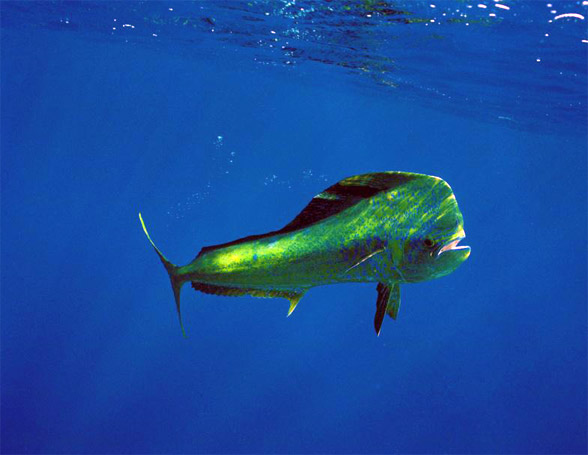Mahi-mahi means "very strong" in Hawaiian (also known widely as dorado) is a surface-dwelling ray-finned fish found in off-shore temperate, tropical and subtropical waters worldwide. 
Mahi-mahi can live up to 5 years, although they seldom exceed four. Catches average 15 to 29 lb. They seldom exceed 33 lb, and mahi-mahi over 40 lb are exceptional.
Mahi-mahi have compressed bodies and a single long-based dorsal fin extending from the head almost to the tail. Their caudal fins and anal fins are sharply concave. They are distinguished by dazzling colors: golden on the sides, and bright blues and greens on the sides and back. Mature males have prominent foreheads protruding well above the body proper. Females have a rounded head. Females are also usually smaller than males.
The pectoral fins of the mahi-mahi are iridescent blue. The flank is broad and golden. 3 black diagonal stripes appear on each side of the fish as it swiftly darts after prey.
Out of the water, the fish often change color, going though several hues before finally fading to a muted yellow-grey upon death.
Mahi-mahi are among the fastest-growing fish. They spawn in warm ocean currents throughout much of the year, and their young are commonly found in seaweed. Mahi-mahi are carnivorous, feeding on flying fish, crabs, squid, mackerel, and other forage fish. They have also been known to eat zooplankton and crustaceans.
Mahi-mahi often swim near debris such as floating wood, palm trees and fronds, or sargasso weed lines and around fish buoys.
Mahi-mahi are highly sought for sport fishing and commercial purposes. Sport fishermen seek them due to their beauty, size, food quality, and healthy population. 
Thirty- to fifty-pound gear is more than adequate when trolling for mahi-mahi. Fly-casters may especially seek frigatebirds to find big mahi-mahis, and then use a bait-and-switch technique. Ballyhoo or a net full of live sardines tossed into the water can excite the mahi-mahis into a feeding frenzy. Hookless teaser lures can have the same effect. After tossing the teasers or live chum, fishermen throw the fly to the feeding mahi-mahi. Once on a line, mahi-mahi are fast, flashy and acrobatic, with beautiful blue, yellow, green and even red dots of color.


Alexa Roggeveen
Author